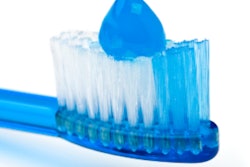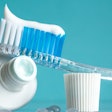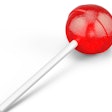
How do you get children to brush their teeth twice a day? A 21-day oral health education program that provided in-school instruction with the goal of making toothbrushing fun had a big impact on the students, according to a new study in International Dental Journal.
The program involves oral health education and consistent toothbrushing at schools, and it was implemented for nearly 8,000 children between the ages of 2 and 12 years. The investigators found that it improved oral health knowledge and toothbrushing frequency, with a second intervention bringing additional benefits.
"This program leads to a sustainable improvement in children's oral health knowledge and behavior, with the best outcomes achieved by 7- to 9-year-old children," the authors wrote (Int Dent J, May 2018, Vol. 68:S1, pp. 7-16).
The researchers were led by Paulo Melo, PhD, an associate professor at the University of Porto Faculty of Dentistry in Portugal, and Charlotte Fine, an education and public health coordinator at the FDI World Dental Foundation in Geneva. The program was developed by the FDI World Dental Federation and Unilever.
Night and day
Adopting good oral hygiene habits earlier makes maintaining oral health later easier, the authors noted. Multiple studies support the importance of introducing good practices earlier, as younger children are more likely to listen and adopt recommended behaviors.
Providing education about oral health in schools is the most effective way to deliver this information to a large audience, they noted. To that end, this three-week program was developed.
In the current study, the program took place at each school twice, with the second time six to 12 months after the first. Two to four dentists and schoolteachers implemented each program.
Representatives from FDI-member national dental associations trained the dental team involved in the study, subsequently training more than 500 teachers to supervise the program. At the beginning of the 21-day period, the team from the national dental association and teachers taught the children proper brushing technique.
The program incorporated five steps:
- Make it understood. Dentists and teachers used flip charts to communicate about oral hygiene and demonstrate the right way to brush teeth. The teacher repeated this for 21 days.
- Make it desirable. Dentists and teachers introduced children to the Brush Day and Night song and pledge, as well as cartoon characters and other aspects of the program designed to make it attractive to children.
- Make it easy. Children received toothbrush and fluoride toothpaste samples to encourage practice at home and an educational pamphlet for parents and other caregivers.
- Make it a habit. Children received a sticker calendar for themselves and adults for recording toothbrushing and instructions for adults to sign a document daily confirming that adults and children had brushed their teeth twice.
- Make it rewarding. Children received daily rewards and a "graduation" celebration on completing the program.
The investigators used a self-reported questionnaire to assess oral health knowledge and behavior in the children and conducted oral exams to measure their plaque levels and dental caries. Children from 10 countries and a total of 86 schools participated in the study. After 21 days, the researchers administered the questionnaire again. When feasible, they repeated the questionnaire and clinical exam six to 12 months from baseline.
The investigators ultimately included 5,148 children from nine countries in their final analysis. Some participants were lost during follow-up.
At baseline, a total of 51% of children said that they brushed twice daily. The number who said they did so increased to 76.7% among the total group after the 21-day program. At the start of the second 21-day intervention, the number rose from 74.4% to 82.2%.
Among all study participants, knowledge and behavior improved by a statistically significant amount (p < 0.001) among all age groups from baseline to 21 days, although the lowest improvement in brushing frequency was seen among children younger than 7 years (see table below).
| Effect of Brush Day and Night program on toothbrushing rates | ||
| Age of children | Baseline | After 1st 21-day program |
| Younger than 7 years | 46.0% | 61% |
| Ages 7 to 9 years old | 58.7% | 91.3% |
| Older than 9 years | 42.5% | 87.4% |
"The study results reinforce this view that programs addressing 2- to 6-year-old children must always consider parents' participation," the authors wrote. "These results show a clear sustainability in 7- to 9-year-old children, especially after six to eight months, and an overall improvement of knowledge and behavior."
The authors also reported better results when the second intervention occurred less than one year from the first intervention.
Quality unclear
The authors noted some study limitations:
- The researchers used a convenience sample that may not be representative of the entire population.
- Some countries and individuals dropped out of the study.
- The questionnaire provided no information on toothbrushing quality.
The effect of repeating the intervention should be studied further, they wrote.
"This study demonstrated that the 21-day Brush Day and Night intervention improves oral health knowledge and behavior of the enrolled schoolchildren," the authors concluded.



















